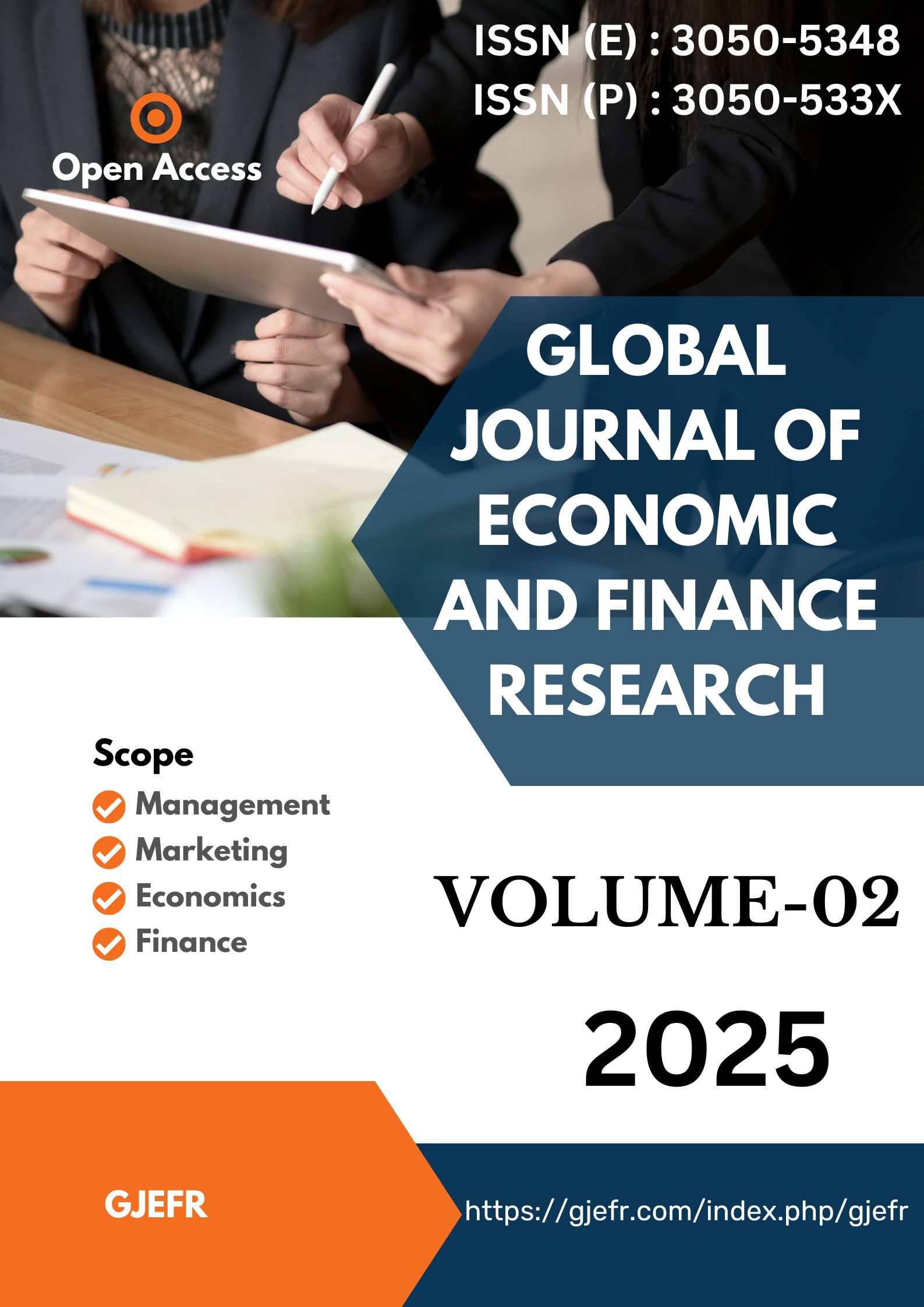VECM Model Analysis of the Causality between Tourism, Foreign Direct Investment and Economic Growth in Tunisia
DOI:
https://doi.org/10.55677/GJEFR/10-2024-Vol01E7Keywords:
Tourism, Economic growth, Foreign direct investment, VECM, Cointegration, Granger Causality, TunisiaAbstract
This paper aims to investigate the causality between tourism, foreign direct investment and economic growth in Tunisia over the period ranging from 1980 to 2018. Time series analysis techniques were used as an econometric tool in this chosen subject, namely, the Augmented Dickey- Fuller (ADF) test for verification of the presence of the root unit, the Engle-Granger test for the existence of cointegration and the Granger causality test for the determination of the causal relationships between the variables of the model. The results of this study have shown a positive relationship between tourism receipts, foreign direct investment and economic growth, and how these three variables are co-integrated of first order. In addition, at the significance level of 5%, there has been: (i) A bidirectional relationship between economic growth and tourism development, that’s mean, the economic growth can contribute to tourism development and vice versa; (ii) A unidirectional relationship between economic growth and foreign direct investment; (iii) Finally, a unidirectional relationship between tourism development and foreign direct investment. This study has also suggested that the government should focus on economic policies to further promote international tourism as a potential source of economic growth in Tunisia.
References
Ashley, C., and Sahli, M. (2007). The role of FDI in tourism: the case of Tunisia, foreign direct investment in tourism: the development dimension, UNCTAD, Geneva.
Abdellaoui, K. and Grimai, L. (2005). FDI, spillovers and growth in developing countries: application to the case of Tunisia and Morocco.
Adames, L. (2000). The relation between the foreign direct investment and the economic growth in Mexico, 1971-1995: Unidad de Investigaciones Económicas, Departamento de Economía, Universidad de Puerto Rico.
Alaya, M. (2004). FDI and economic growth: the case of Tunisia, GDRI EMMA Doctral Seminar, University of Nice Sofia Antipolis.
Amira hmadi, H., and Wu, W. (1994). Foreign direct investment in developing countries. The Journal of Developing Areas, 28 (2), 167-190.
Biswas, R. (2002). Determinants of Foreign Direct Investment. Development Economics Review, 6 (3), 492-504.
Balaguer, J., and M. Cantavella-Jordá, (2002). Tourism, long-term factor of economic growth: the Spanish case, applied economy, 34, pp. 877-884.
Belloumi, M., (2010). The relationship between tourism receipts, real effective exchange rate and economic growth in Tunisia, International Journal of Tourism Research, 12, 550-560.
Choyakh H., (2008). A model of tourism demand for Tunisia: the inclusion of the tourist investment variable Economy Tourism, 14 (4): 819-838.
Cortes-Jimenez, I., J.Nowak and M. Sahli, (2011). Mass seaside tourism and economic growth: Lessons from Tunisia, Tourism Economics, Vol.17, No.3, pp 531-547.
Dickey, D. and W. Fuller, (1979). The distribution of estimators for autoregressive time series with a unit root, Journal of the American Statistical Association, Vol 74, pp 427-431.
Dritsakis, N., (2004). Tourism as a driver of long-term economic growth: An empirical survey for Greece using causality analysis, Tourism Economics, 10 (3), pp. 305-316.
Durbarry, R., (2004). Tourism and Economic Growth: The Case of Mauritius, Tourism Economics, 10 (4), pp 389-401.
Enders, W. (1995). Application of Econometric Time Series (Vol 311). John Wiley and Sons.
Enders, W. (2008). Application of econometric time series. John Wiley and Sons.
Engle, R. F., and Granger, C. W. (1987). Co-integration and error correction: representation, estimation and tests. Econometrica: Journal of the Econometric Society, 251-276.
He, L. and X. Zheng, (2011). Empirical Analysis of the Relationship between Tourism Development and Economic Growth in Sichuan, Journal of Agricultural Science, Vol. 3, No. 1, pp. 212-217.
Johansen, S. and K. Juselius, (1990). The estimation of maximum likelihood and inference on co-integration with application to the demand for money, Oxford Bulletin of Economics and Statistics, 52, 169-221.
Karray, Z. and S. Toumi (2007). Foreign direct investment and attractiveness: appreciation and challenges for Tunisia, Regional and Urban Economics Journal, 3: 479-501.
Kim, J.H., Chen, M.H., and Jang, S. (2006). The expansion of tourism and economic development: the case of Taiwan. Tourism Management, 27 (5), 925-933.
Katircioglu, S., (2009b). Trade, tourism and growth: The case of Cyprus. Applied Economics, 41 (21), 2741-2750.
Lakhoua, Fayçal, (2001). FDI in Tunisia: evolution, impact and openness. (April).
Lee, C.C. and C.P. Chang, (2008). Tourism Development and Economic Growth: A Closer Look at the Panels, Tourism Management, 29, pp. 180-192.
Mishra, P.K., Rout, H.B. and Mohapatra, S.S. (2011). "Causality between Tourism and Economic Growth: The Empirical Evidence of India", European Journal of Social Sciences, 18 (4): 518-527.
Nitasha Sharma (2018). Tourism Led Growth hypothesis: empirical evidence from INDIA. African journal of hospitality, tourism and Leisure, Volume 7(2).
Tasos Stylianou (2017). The contribution of tourism development in Mediterranean countries. A dynamic Panel Data Approch. SPOUDAI Journal of Economics and B usness, Vol, 67, Issue 2, pp85-100.
Downloads
Published
Issue
Section
License
Copyright (c) 2024 Global Journal of Economic and Finance Research

This work is licensed under a Creative Commons Attribution 4.0 International License.

